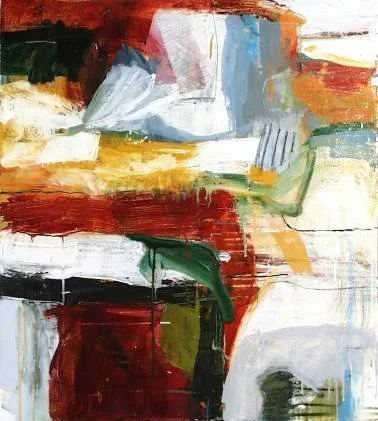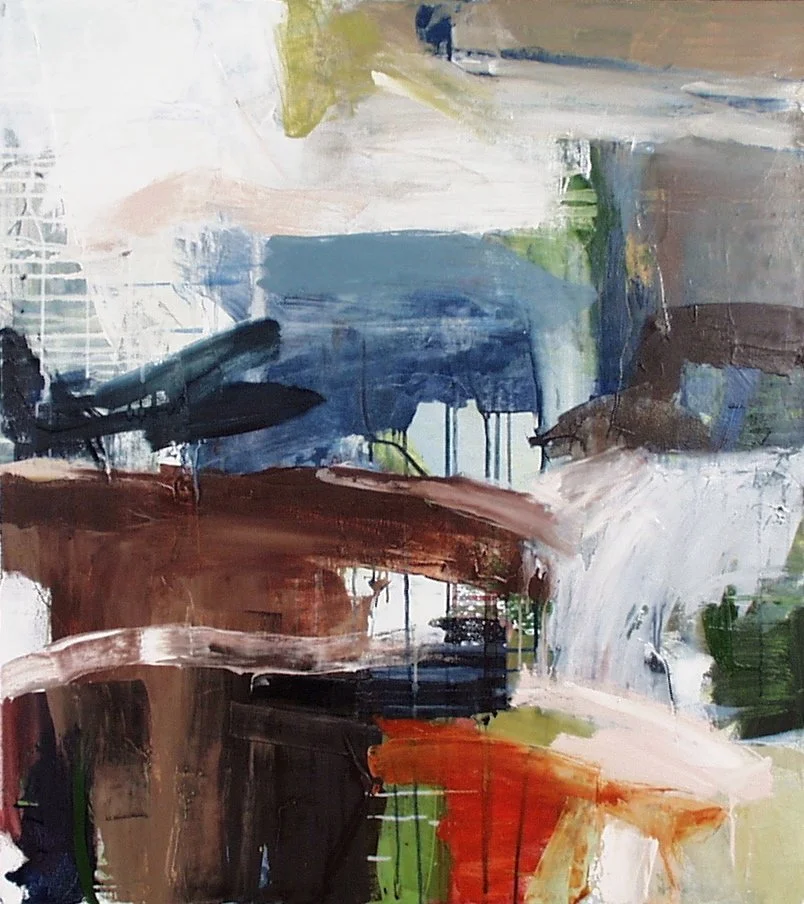Abstraction and Nature
Donald Kuspit
It has been said that all politics is local, and one can’t help but wonder whether all art is local, that is, grounded in a response to a particular environment. This certainly seems the case with Michael Rich’s paintings. A Southerner by birth, a New Englander by choice, and Italian in sensibility, Rich states: “A lifetime spent around the island waters of Nantucket and later, the hills of Cortona, Italy helped to shape a love and interest in landscape and natural rhythms of color that remain very much a focal point in [my] work today.” Rich paints abstract landscapes, more particularly, expressionistic landscapes that reflect what the art historian Meyer Schapiro called the modern painter’s preference for “the spontaneous” and “the immediately felt,” involving “delight in color and movement” as well as “individual fantasy” suggestive of “inner freedom.” Schapiro adds that the modern abstract painter often discovers his “subjects on the canvas while at work.” (1)
But Rich clearly knows his subject beforehand: the issue is how to record his sensations of nature, and the feelings they evoke in him, not how to represent some familiar aspect of it. Rich is a modernist painter, sensitive to his medium, but for him paint is not an end in itself - however purely he paints - but a means to an emotional and even existential end: the articulation of the feeling of being alive in the presence of nature--always stimulating and at times almost overstimulating, as the intensity of Rich’s colors and complexity of his rhythms suggests. For Rich sensitivity to paint is inseparable from sensitivity to landscape, and the fluid density of landscape is best conveyed by the fluid density of paint. What kind of landscape? A first glance suggests a blend of the harsh, raw New England landscape, whose turbulent materiality makes itself felt in Force of Nature and Nor’Easter, both 2005, and the softer, cultivated landscape of Italy, whose manicured eloquence makes itself felt in The Color of Sky series, 2005. But a second, more considered glance reveals something else: a split between sturdy wall building, as it might be called - painterly blocks of color, more or less brash, are piled on top of each other to wall off the white canvas, but incompletely, so that bits and pieces of it remain visible, and its whiteness becomes sublimely luminous by way of the vivid colors that contrast with it - and, on the other hand, delicate, excited, even whimsically manic works, such as Traces and Whispers, 2002 and Remembrance IV and V, both 2005. I am suggesting that Rich tends to the epic, as though to convey the monumental presence and impact of nature, but also to the lyric, as though to remind us of its many changing moods. As the saying goes, you can’t step in the same stream twice, which is certainly true of nature, but the stream has a pattern or rhythm to its flow, indicating that it is not as arbitrary as it seems. It submits to eternal law, as its cyclic character indicates, just as human nature submits to the eternal laws and cycles of emotion.
In Rich’s paintings natural change--constantly changing atmosphere and light, suggesting that nature is in perpetual process and motion, and thus always unfinished, that is, a cosmic work of art in the making but impossible to finalize—and emotional change directly correlate and correspond. Rich’s abstract landscapes restore us to the pre-reflective - not to say prelapsarian--state of unity between object (nature) and subject (sensation and feeling) we experienced before we discovered our separateness from nature (or rather our difference within nature). Thus their mystic import, and with that their sense of radical aliveness. Obviating the conventional duality between object and subject reminds us that we are part of nature by way of our sensations and feelings. Like the changing seasons, they are organic expressions of life: Rich’s peculiarly apocalyptic The Coming of Autumn, 2004, with its dramatic interaction of colors, as though in a final efflorescence - greens, reds, whites, and yellows rush across the stage of the canvas, dueling all the way - has as much to do with violent emotions as with the changing season.
But there is a sense of control in Rich’s paintings, for all their impacted violence. Sister Sky, 2005 clearly has a geometrical structure, and there is a sense of emerging geometrical organization in such obviously gestural, splashy paintings as The Color of Sky I, 2005 and Red Sky Remaining, 2004. In the latter layer builds upon layer, in the former there’s a central focus. Even in Nor’Easter and Force of Nature there is a sense of structure - a subliminal organization more or less manifest through the play of horizontal and vertical gestures. For me, the January Series I and VIII, both 2005, along with Light of My Life, 2004 and Written on the Surface, 2002 are among the most subtly structured-unstructured paintings--eloquently ambiguous in what might be called their gestural geometry.
Modernist painting is all about surface, and Rich’s modernist paintings are no exception. What I think is special about his surface is that luminosity seems immanent in every gesture, conveying a sense of inner sublimity. In John Marin, an earlier New England abstract landscape painter with a strong modernist streak, the light seems extraneous and supplemental. It hangs over the landscape rather than pervades it, so that it seems far from innate to nature--indeed, above and beyond it - rather than essential to it, as it does in Rich’s paintings. It seems no accident that Rich paints a homage to Turner: in JMW (to Turner), 2003 light is simultaneously transcendental and intimate. Marin gives us transcendental light but not intimate immanent light, while Turner and Rich give us both, if in very different ways, no doubt because Rich is an abstract expressionist rather than a naturalist painter tending to abstract expression, like Turner. It is also worth noting that Rich, like Turner, is a romanticist: his nature is as much a fantasy as a felt experience.
Seeing so many paintings that evoked the sky - much more than the earth, although Rich’s sky often has the density of the earth - I could not help but think of Ruskin’s Modern Painters, dedicated to the landscape painters of England (with special attention to Turner), and with a long section devoted to what Ruskin called “Cloud Beauty.”(2) Aware of what he called the “waywardness” of clouds, Ruskin also was aware of “Cloud Balancings,” “Cloud Flocks,” and “Cloud Chariots,” that is, formations of clouds that belied their waywardness. I don’t see any cloud chariots in Rich’s abstract skyscapes, but I do so see cloud balancings and cloud flocks, and, more subtly, I see what Ruskin called “cloud perspective,” which he diagrammed. There does indeed seem to be a diagrammatic underpinning to many of Rich’s paintings, and, on the other hand, a flocking together of fleeting gestures. I think Rich is trying to do what Hans Hoffman did in his late California paintings: integrate the extremes of geometrical and gestural abstraction, thus creating a new simultaneity of dynamic equilibrium and inner necessity, as well as draw with color. For Rich’s paintings seem drawn as well as painted, that is, subliminally linear as well as overtly painterly. His gestures often have clear and distinct edges - they are often carefully demarked - however amorphous they initially look.
Balance is as important to Rich as energy--the difficulty is always to achieve an energized balance, in which each element is allowed its own physical distinctiveness and given its own emotional valence while taking its place in what David Bohm famously called the implicate order. Rich’s over all paintings suggest the abstract topography of this order while mapping its natural and emotional expression, thus turning it into a living terrain. It is worth noting that Rich is “a dedicated practitioner of yoga” and “influenced greatly by Eastern philosophy and art.” He conceives of his paintings as “spiritual investigation[s]” into nature, that is, efforts to articulate the inherent spirituality of nature. They certainly invite meditation - but then, for all their balance, they seem unstable, while Eastern landscapes, however intricate and even agitated, seem inherently stable, and thus more conducive to concentrated meditation. Rich’s sense of balance is more precarious - or should one say quixotic? - than it seems at first glance; indeed, the drips suggest that it is built on quixotic paint. Rich, after all, is American, and Abstract Expressionism is full of American energy, as the works of Pollock and de Kooning make transparently clear. I want to suggest that his Eastern “edge” has more to do with his pursuit of a slowly working or paced “aesthetic shock” (samvega) than with yoga self-control and physical and mental discipline. If spirituality means consciousness of aliveness, independently of what is alive - and all things are alive or have an indwelling consciousness from a spiritual point of view - then aesthetic shock is a way of becoming aware of aliveness as a universal phenomenon.
Ananda Coomaraswamy writes: “it is not only in connection with natural objects (such as the dewdrop) or events (such as death) but also in connection with works of art, and in fact whenever perception (aisthesis) leads to a serious experience, that we are truly shaken”(3) - that is, shaken to the roots of our existence. Aesthetic shock involves a revolutionary alteration of consciousness that brings with it a radical awareness of the givenness of existence. I think that Rich is trying to fuse the aesthetic shock he experiences when he observes nature and the aethetic shock of a serious painting--a painting that takes painting as such seriously--to shock us into awareness of the fundament of our existence, and with that of its embeddedness in nature, and thus of our aliveness and of the aliveness of everything whatsoever in nature. I think all important landscape painting aims to achieve thus dialectical shock, and I think Rich’s landscape paintings achieve it, slowly but surely. They make us conscious of the absolute aliveness of nature, all the more so because they are abstract, so that there is not the distraction of looking at this or that detail of empirical nature. Joan Mitchell’s late abstract paintings do the same thing for landscape, but Rich’s landscape is different and peculiarly fresher, not only because it is New England and Italian landscape, as noted, but because Mitchell, working in Giverny and conscious of Monet’s landscape paintings, does a kind of epitomizing reprise of his paintings, that is, sees the living landscape through Monet’s style. One wonders whether she’s more conscious of the landscape or of his paintings. Rich sees the landscape through his own eyes, which is why his painterliness has a certain innocence for all its abstract expressionist character. His paintings are homages to nature rather than reprises of Abstract Expressionism, suggesting that it is still possible to see nature with fresh eyes however much it must finally - and tragically - be mediated through some known style, which perhaps explains the peculiar aura of reminiscence, that is, sedimented, memorable experience of art as well as of nature, that haunts Rich’s paintings.
Notes
(1)Meyer Schapiro, “Recent Abstract Painting,” Modern Art: 19th and 20th Centuries (New York: George Braziller, 1990), p. 218 remarks that “the [modernist] painting symbolizes an individual who realizes freedom and deep engagement with the self within his work,” adding that it is “the occasion of spontaneity or intense feeling.”
(2)John Ruskin, Modern Painters (Boston: Dana Estes, 1902), pp. 140- 200
(3)Ananda Coomaraswamy, “Samvega: Aesthetic Shock,” Selected Papers (Princeton: Princeton University Press, 1977, vol. 1, p. 182
Donald Kuspit
Critic, Professor Emeritus of Art and Philosophy, Stony Brook University, Contributing Editor at Artforum, Sculpture, and Tema Celeste. Among his numerous publications, he is the author of The Cult of the Avant-Garde Artist (Cambridge University Press, 1993), The Rebirth of Painting in the Late 20th Century, (Cambridge University Press, 2000) and The End of Art (Cambridge University Press, 2004).
Essay Written for the Exhibition Catalog, Michael Rich at the George Billis Gallery, NY, 2006
With sincere thanks to Basil Alkazzi for support of this publication




